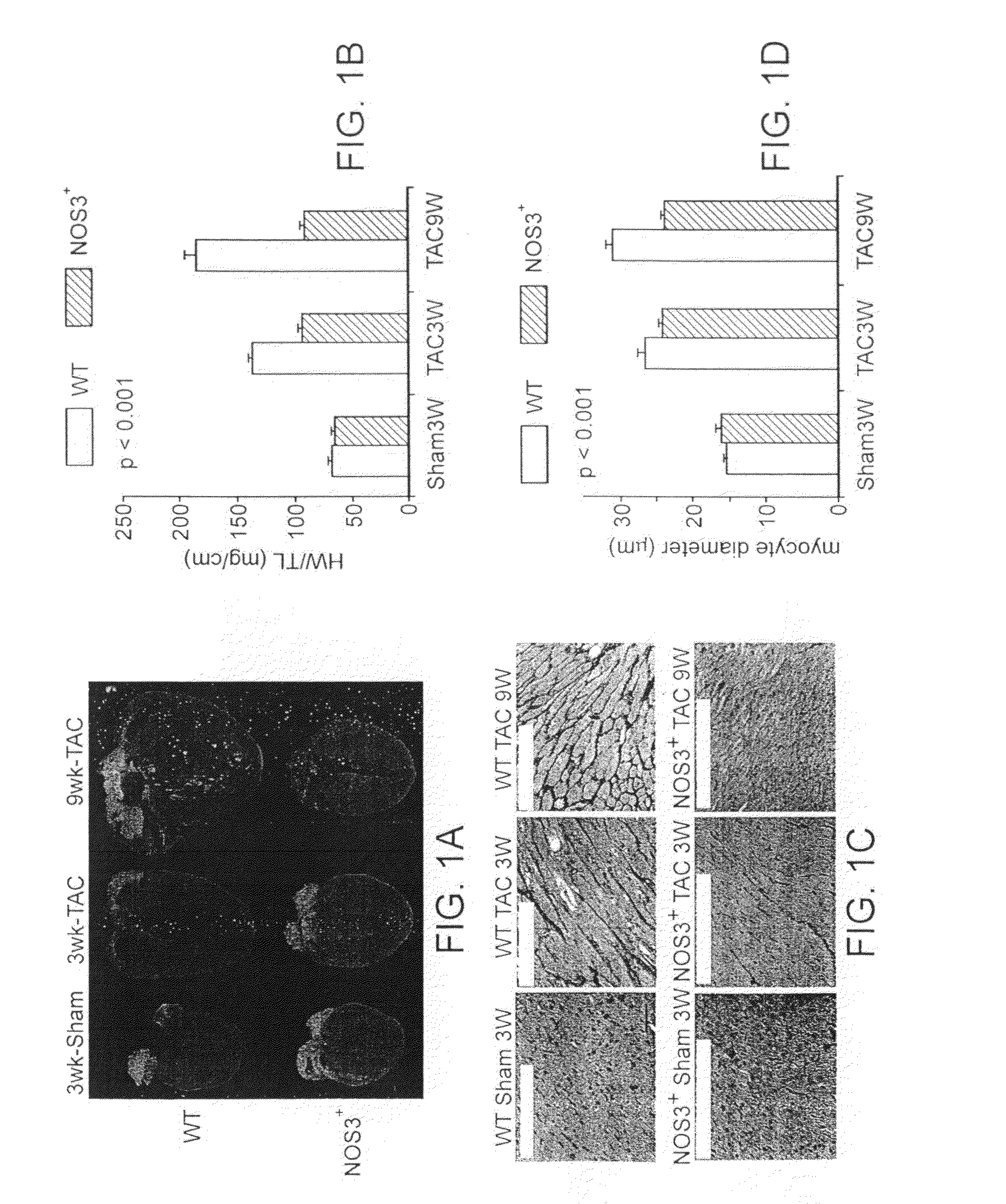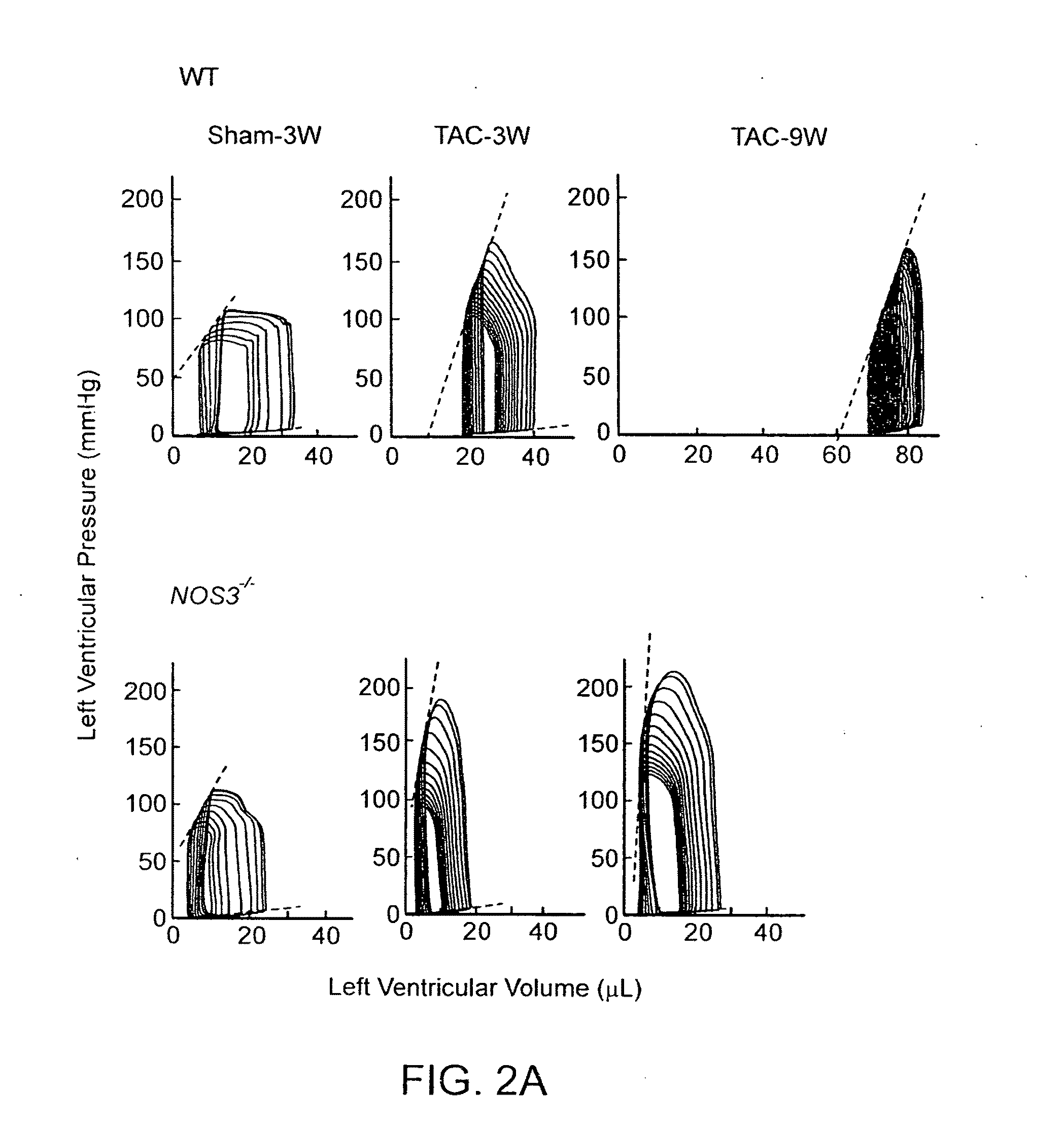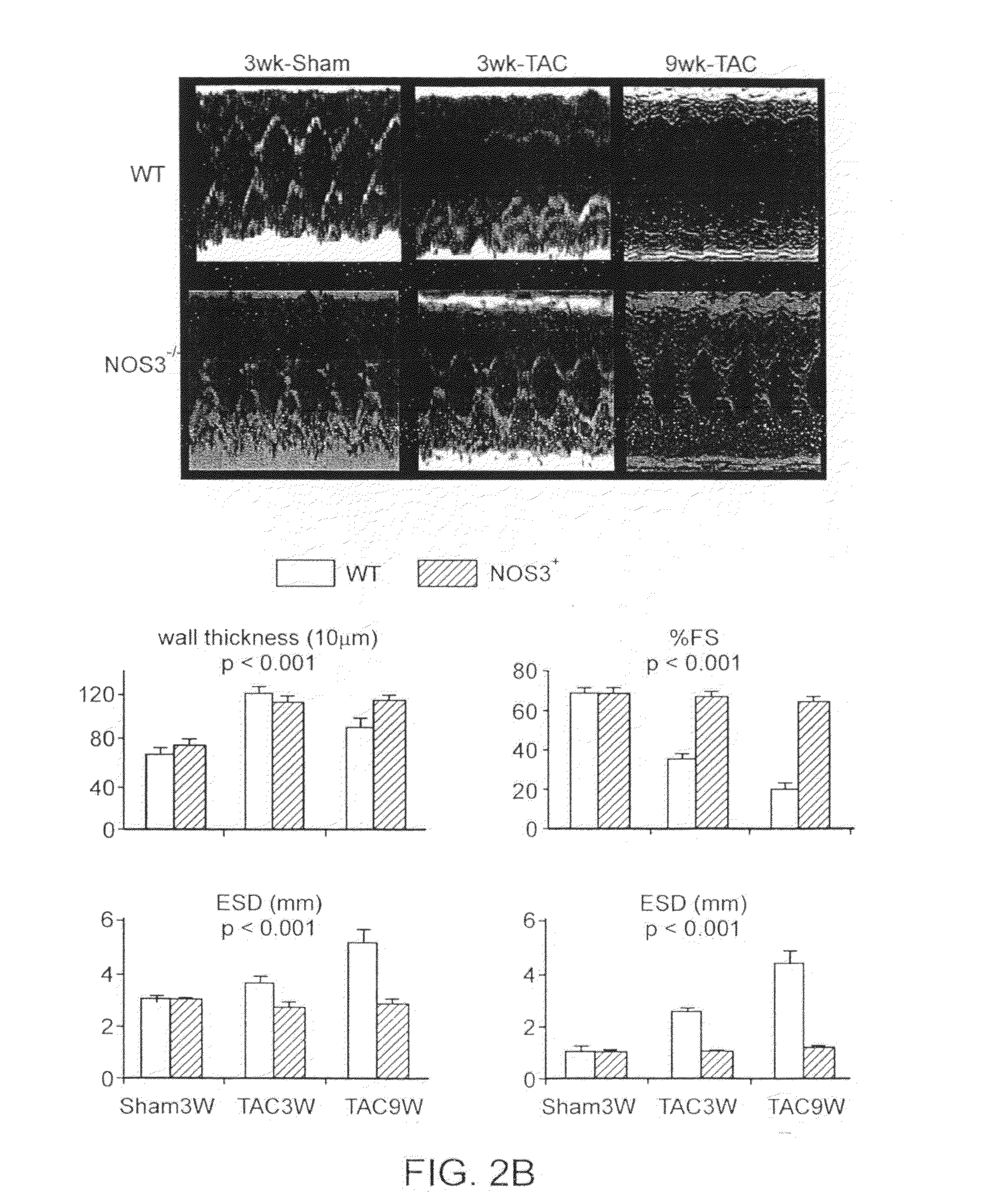Use of a Nitric Oxide Synthase Modulator for the Treatment of Cardiac Indications
a technology of nitric oxide synthase and modulator, which is applied in the direction of biocide, cardiovascular disorder, drug composition, etc., can solve the problems of heart failure, insufficient prevention of pathological changes in existing therapies, hypertrophy that can progress to heart failure, etc., and achieve the effect of restoring the anti-adrenergic effect and enhancing the physiologic regulation of heart function
- Summary
- Abstract
- Description
- Claims
- Application Information
AI Technical Summary
Benefits of technology
Problems solved by technology
Method used
Image
Examples
example 1
Lack of NOS3 Ameliorated Cardiac and Myocyte Hypertrophy, Dilation, and Fibrosis Due to Transverse Aortic Constriction
[0129]In control wild-type mice, heart weight normalized to tibia length (HW / TL) increased 100% after 3-weeks of pressure-overload induced by transverse aortic constriction (TAC), and by 175% after 9 weeks (FIGS. 1A and 1B). This was accompanied by near doubling of myocyte diameter (at 9 weeks) and increased interstitial fibrosis (FIGS. 1C and 1D). Collagen fraction rose 0.1±0.1% to 4.0±0.8% after 9 weeks TAC (p− / −-hearts was far more modest, with an increase in myocyte size nearly half that of wild-type after 9-weeks of TAC, and chamber size was smaller (i.e. concentric hypertrophy). Basal collagen fraction was somewhat elevated in NOS3− / −-hearts although still low (1.5±0.7%), but this did not change with TAC (e.g. 1.9±0.9% 3-weeks, similar results at 9-weeks). Importantly, NOS3− / − and wild-type hearts had similar heart mass and myocyte size at baseline, and the ris...
example 2
Lack of NOS3 Ameliorates Left Ventricular Dysfunction Induced by Transverse Aortic Constriction
[0130]Marked disparities of in vivo cardiac function were observed between wild-type and NOS3− / − animals exposed to TAC (FIGS. 2A and 2B, Table 1), with wild-type-TAC displaying progressive cardiac decompensation while NOS3− / − hearts had preserved or even enhanced function.
TABLE 1TAC induced changes in cardiac morphology and left ventricular functionGenotypeBaselineTAC3WTAC9WANOVABody Weight (gm)WT27.6 ± 0.627.2 ± 0.326.5 ± 0.5a, cNOS3− / −26.1 ± 0.3 25.9 ± 0.2* 29.9 ± 0.2*Heart Weight (mg)WT122.9 ± 4.0 241.1 ± 6.8 344.0 ± 20.0a, b, cNOS3− / −116.1 ± 2.4 165.3 ± 5.3*166.3 ± 4.0*Heart Rate (min−1)WT522.6 ± 13.7520.0 ± 13.0 542 ± 8.6aNOS3− / − 499 ± 5.0500.3 ± 18.3589.1 ± 18.0LV Systolic PressureWT107.0 ± 2.2 179.9 ± 3.1 168.0 ± 5.1 a, b, c(mmHg)NOS3− / −120.7 ± 3.8*182.8 ± 3.5 212.4 ± 6.7*LV End DiastolicWT 5.4 ± 0.6 7.1 ± 1.4 5.1 ± 1.1Pressure (mmHg)NOS3− / − 7.1 ± 0.4 7.5 ± 0.7 7.9 ± 1.4Effective A...
example 3
Differential Response in Fetal Gene Expression
[0132]In wild-type controls, TAC (3-weeks) triggered fetal gene re-expression, increasing mRNA levels for type A and B natriuretic peptides (NP), β-myosin heavy chain (β-MHC), α-skeletal actin (α-SA), and reducing expression of phospholamban (PLB) and sarcoplasmic reticulum Ca2+ ATPase (SERCA2a) (all p− / − hearts, TAC induced similar changes in some of these genes but not in others. In particular, type B-NP and α-SA were enhanced to a lesser extent, whereas type A-NP and β-MHC were similarly elevated in both genotypes. PLB declined less with TAC in NOS3− / − (p<0.05), while a directionally similar disparity in SERCA2a expression fell short of significance. Thus, different hypertrophy phenotypes between groups were accompanied by selective fetal gene re-expression.
PUM
| Property | Measurement | Unit |
|---|---|---|
| concentration | aaaaa | aaaaa |
| apparent volume of distribution | aaaaa | aaaaa |
| temperatures | aaaaa | aaaaa |
Abstract
Description
Claims
Application Information
 Login to View More
Login to View More - R&D
- Intellectual Property
- Life Sciences
- Materials
- Tech Scout
- Unparalleled Data Quality
- Higher Quality Content
- 60% Fewer Hallucinations
Browse by: Latest US Patents, China's latest patents, Technical Efficacy Thesaurus, Application Domain, Technology Topic, Popular Technical Reports.
© 2025 PatSnap. All rights reserved.Legal|Privacy policy|Modern Slavery Act Transparency Statement|Sitemap|About US| Contact US: help@patsnap.com



